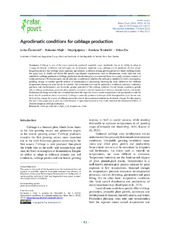Приказ основних података о документу
Agroclimatic conditions for cabbage production
Agroklimatski uslovi za proizvodnju kupusa
| dc.creator | Červenski, Janko | |
| dc.creator | Vlajić, Slobodan | |
| dc.creator | Ignjatov, Maja | |
| dc.creator | Tamindžić, Gordana | |
| dc.creator | Zec, Srđan | |
| dc.date.accessioned | 2023-03-08T09:31:16Z | |
| dc.date.available | 2023-03-08T09:31:16Z | |
| dc.date.issued | 2022 | |
| dc.identifier.issn | 2217-8392 | |
| dc.identifier.issn | 1821-3944 | |
| dc.identifier.uri | http://fiver.ifvcns.rs/handle/123456789/3328 | |
| dc.description.abstract | Cabbage is one of the most commonly produced vegetable crops worldwide due to its ability to adapt to a range of climatic conditions and soil types. As an intensive vegetable crop, cabbage can be produced all year round. Regarding the fact that cabbage needs optimum agroclimatic conditions during growing period for better yielding results, the paper aims to clarify and define the specific agroclimatic requirements, such as temperature, water, light and soil, suitable for cabbage production. Cabbage production should take place on a seasonal basis, as an early, summer, autumn, or winter production. Production goals should take into consideration whether the cabbage is intended for fresh consumption, pickling, storage or another specific method of consumption or processing. Growing the same cultivar in two different temperatures during one year should be avoided. The combination of suitable production conditions, intensive cultivation practices and mechanisation, can boost the genetic potential of the cabbage cultivars. Local climate conditions greatly affect cabbage production, primarily plant growth, occurrence and development of diseases, harmful insects, and weeds. Production planning must take into consideration both the regional (mean annual temperatures and precipitation) and the local climate conditions (frost occurrence). Cabbage is currently produced in the open field throughout the year, but we may be forced to change the course of cabbage production due to the increase of extreme local climate change. For this reason, the aim of this paper was to give recommendations of agricultural practices that could minimize the detrimental effects of climate change in cabbage production. | sr |
| dc.description.abstract | Kupus je jedno od najpopularnijih povrća na svetu zbog prilagodljivosti širokom rasponu klimatskih uslova i vrsti zemljišta. Predstavlja povrtarsku vrstu koja može da se proizvodi tokom cele godine. Da bi se ostvarili što veći prinosi, kupus mora imati optimalne agroklimatske uslove tokom vegetacione sezone. Iz tog razloga u radu smo hteli da približimo i definišemo potrebe kupusa za agroklimatskim uslovima proizvodnje, kao što su temperatura, voda, svetlost i zemljište. Proizvodnja kupusa treba da se odvija po principu sezonskog karaktera, kao rana, letnja, jesenja, ili zimska. Sledeći kriterijum treba da bude cilj proizvodnje, tj. da li je kupus namenjen svežoj potrošnji, kišeljenju, lagerovanju ili određenom načinu potrošnje/prerade. Trebalo bi izbegavati proizvodnju jedne iste sorte u dve temperaturno različite sezone tokom godine. Uspešnost proizvodnje u određenim agro-klimatskim uslovima u velikoj meri zavisi upravo od pravilnog odabira sorte. Pravilnom kombinacijom uslova proizvodnje, intenzivne agrotehnike i odgovarajuće mehanizacije možemo doprineti boljem ostvarivanju genetskog potencijala sorte kupusa. Lokalni klimatski faktori su bitan činilac u proizvodnji kupusa, kako sa aspekta razvića samih biljaka, tako i sa apekta pojave i razvoja bolesti, štetnih insekata i korova. Prilikom planiranja proizvodnje potrebno je uzeti u obzir regionalne (srednja godišnja temperatura i količina padavina) i lokalne (opasnost od mraza) klimatske uslove. Kupus se trenutno proizvodi na otvorenom polju tokom cele godine, ali zbog sve većih ekstremnih lokalnih klimatskih promena možemo biti primorani da koriujemo određeni deo proizvodnje kupusa. Iz tog razloga, cilj ovog rada bio je da ukaže na preporuke poljoprivredne prakse koje bi mogle da minimiziraju štetne efekte klimatskih promena u proizvodnji kupusa. | sr |
| dc.language.iso | en | sr |
| dc.publisher | Novi Sad : Institute of Field and Vegetable Crops | sr |
| dc.relation | info:eu-repo/grantAgreement/MESTD/inst-2020/200032/RS// | sr |
| dc.rights | openAccess | sr |
| dc.rights.uri | https://creativecommons.org/licenses/by/4.0/ | |
| dc.source | Ratarstvo i povrtarstvo | sr |
| dc.subject | gajenje | sr |
| dc.subject | kupus | sr |
| dc.subject | svetlost | sr |
| dc.subject | temperatura | sr |
| dc.subject | voda | sr |
| dc.subject | zemljište | sr |
| dc.subject | cabbage | sr |
| dc.subject | cultivation | sr |
| dc.subject | light | sr |
| dc.subject | soil | sr |
| dc.subject | temperature | sr |
| dc.subject | water | sr |
| dc.title | Agroclimatic conditions for cabbage production | sr |
| dc.title | Agroklimatski uslovi za proizvodnju kupusa | sr |
| dc.type | article | sr |
| dc.rights.license | BY | sr |
| dc.rights.holder | Authors | sr |
| dc.citation.epage | 50 | |
| dc.citation.issue | 2 | |
| dc.citation.rank | M51 | |
| dc.citation.spage | 43 | |
| dc.citation.volume | 59 | |
| dc.identifier.doi | 10.5937/ratpov59-36772 | |
| dc.identifier.fulltext | http://fiver.ifvcns.rs/bitstream/id/9294/bitstream_9294.pdf | |
| dc.identifier.scopus | 2-s2.0-85139218197 | |
| dc.type.version | publishedVersion | sr |


